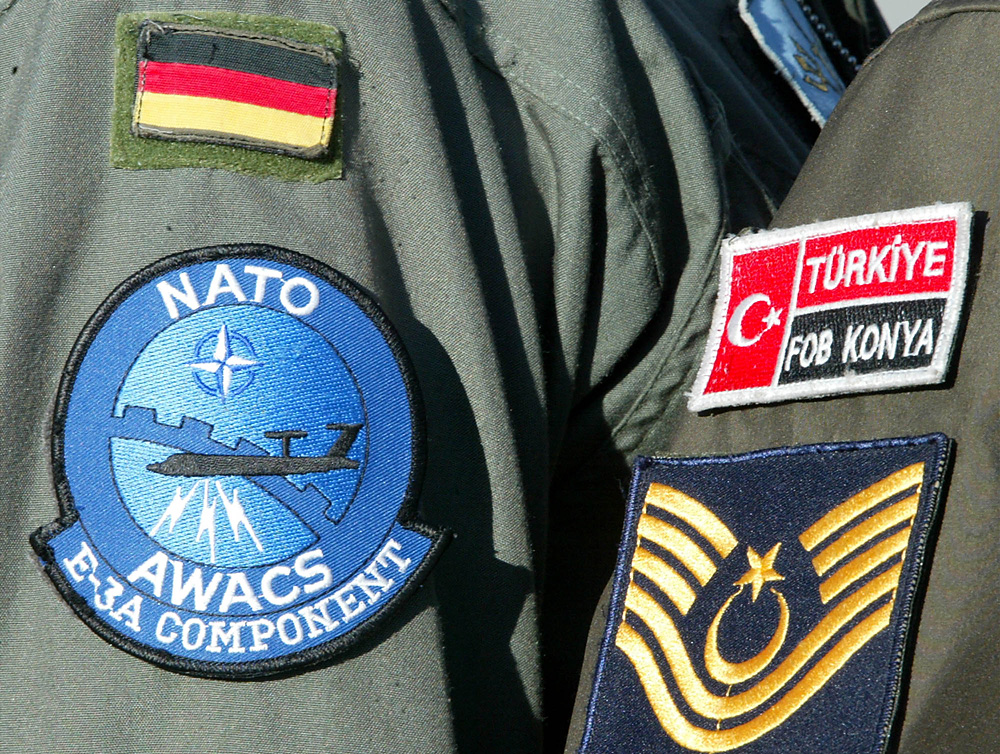
A Turkish NATO MP guards together with a German crew member one of three AWACS planes, based at the Forward Operation Base in Konya, Turkey.
APWhen Turkey’s Foreign Ministry refused to allow the Russian military to conduct an observation flight over Turkish military facilities near the Syrian border and NATO airfields scheduled to take place between Feb. 1 and Feb. 5, Moscow reacted, accusing Turkey of breaching international aviation protocol.
Russia claims it had a legal basis for carrying out the observation flight under the Treaty of Open Skies, although the Open Skies Consultative Commission (OSCC), the Vienna-based organization responsible for facilitating the treaty’s implementation, has so far made no comment on the incident.
However, in the wake of Ankara’s refusal to sanction the flight, Russia is now asking questions about the true nature of the NATO facilities in Turkey and whether they are truly being used in the interests of the alliance – or whether Turkey is using them for its own goals in Syria.
The most understandable situation concerns NATO's airfields. Actually, this is just one base, Incirlik, which is used by both the Turks and the Americans. Historically, the U.S. and Turkey have had complex military-technological relations.
After Turkey's invasion of Cyprus in 1974, U.S. Congress froze military-technological cooperation with Ankara, despite Turkey being part of NATO.
After it lifted the arms embargo in 1978 the U.S. in fact lost its access to another base – in Izmir (if we were to exclude the presence of the 425th Air Force squadron), but optimized its supply system in Incirlik, which strategically was directed against the USSR.
With the beginning of the wars in Iran the airbase in Incirlik was used for patrolling airspace north of the 36th parallel. With this objective the so-called 39th American supply wing was deployed there, along with 5,000 military personnel. Meanwhile, Turkey uses the American Boeing KC-135 Stratotanker refuellers in what seems to be a bilateral agreement between the countries.
The status of Izmir as a NATO base was restored after the Cyprus crisis, and today it houses headquarters that coordinate work with the south-eastern theater. However, it seems that Russia did not intend to fly over Izmir, since it is too far from the current war zone and besides, the roughly 300 Turkish planes there generally operate against Greece.
There is also the airbase in Konya, which has a long-distance radar reconnaissance unit. In total there are 20 Turkish airports with various runways that NATO can use in times of peace and about 100 that the alliance can use during war. The airbases in Erzurum, Kaymakli, Murted, Balikesir and Incirlik possess nuclear ordnance. According to various estimates, NATO forces in Turkey have several hundred nuclear devices of different capacities.
At the end of 2014 Turkey and the U.S. agreed to use Incirlik also for deploying American military drones in support of the West's coalition against Islamic State.
In general, American interest in the Incirlik base has lately been fading then kindling again – depending on how active the preparation for offensive operations in Kurdistan are, including the various attempts to wrestle Mosul from ISIS control.
In periods when Washington refused to support the Kurds, it switched to traditional aviation with aircraft carriers in the Persian Gulf. But as soon as there was talk about an offensive in Iraqi Kurdistan, the Americans realized that they needed a base that was close to Kurdistan geographically.
In turn, Turkey torpedoed U.S. attempts to strengthen its position in Incirlik, since that would imply closer cooperation between Washington and the Kurds, something that is deadly for Ankara. Perhaps the American presence in Incirlik will have a symbolic significance in the future, while the Turkish air force will continue exploiting American refuellers without giving anything in return.
That is why Turkey's refusal to allow a Russian surveillance flight over the airbase in Incirlik does not imply "an ally's care" for U.S. positions in the region, but most likely the contrary – that Turkey uses the NATO base exclusively for its own aims but cunningly says that they are American interests.
Meanwhile, a territory of just over 45 square kilometers near the city of Diyarbakir (Turkish Kurdistan) contains several early warning radar stations and satellite communication systems.
The biggest NATO center in Turkey, it is responsible for monitoring airspace, and can observe the entire Mediterranean basin, as well as monitor the movements of ships and airplanes at a distance of several thousand kilometers. The powerful radars are equipped with automatic data processing systems and are capable of receiving information on the launching of ballistic missiles.
Finally, in the vicinity of the Turkish city of Sinop on the Black Sea there is a NATO electronic intelligence center. Here modern antennas and analytical apparatuses help monitor radio communication throughout the region.
These are the radars that will be the first to receive information on the activity of Russia's air force in Syria and on the launching of Russian cruise missiles from the Caspian and Mediterranean Seas.
First published in Russian in Vzglyad.
All rights reserved by Rossiyskaya Gazeta.
Subscribe
to our newsletter!
Get the week's best stories straight to your inbox